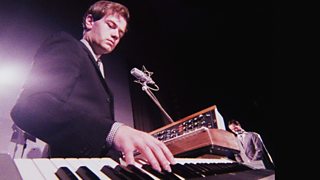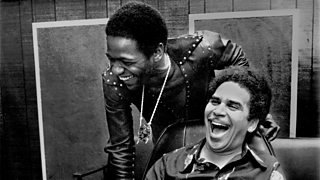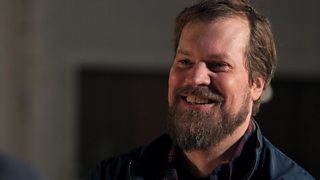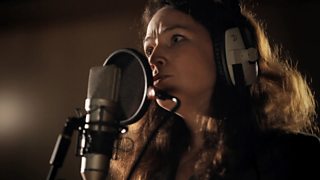Sound of Song: Mix it up and start again
29 January 2015
Composer and musician NEIL BRAND's series Sound of Song explores the impact of technology on the development of music and songs. Here, Neil writes on the breakthrough sounds of Kraftwerk and the rise of the synthesiser, dance music from Tom Moulton to Public Enemy, and the purist backlash in music production. And he reflects on where the song will go from here.

On January 18th 1974, I sat in the Royal Festival Hall with a crowd from my school (thanks to an enterprising schoolmaster who'd organised the trip) watching Rick Wakeman perform and record the premiere of Journey to the Centre of the Earth.
Rick had been my hero since his 1973 debut solo album Six Wives of Henry VIII - he not only made rock piano sexy (he'd been doing that since Bowie's Life on Mars) but made keyboards the centre of the rock universe - eight of them, at a rough count, surrounding his caped figure centre-stage.
Kraftwerk put the synthesiser behind their entire sound and ushered in a decade of synth-driven pop and dance music
Interviewing him for this series as he praised the Mini-Moog and excoriated the fabulous but temperamental Mellotron was a high point for me.
Music technology became the driver of pop and rock from the 1960s onwards, the new textures it offered inspiring more ambitious ideas from an enterprising new generation of musicians.
Kraftwerk put the synthesiser behind their entire sound, culminating in Autobahn in 1974, and in doing so ushered in a decade of synth-driven pop and dance music.

Exclusive Kraftwerk clips
Neil Brand writes...
-
![]()
The Recording Revolution
The birth of recorded music, W.C. Handy and the blues, and Irving Berlin
-
![]()
Reeling and Rocking
The sounds of Sinatra, Presley and Al Green, and the growth of a new creative personality in the studio - the producer
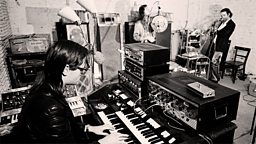

Autobahn is... more than just a record, it is an indictment. An indictment of all those who would resist the bloodless iron will and order of the ineluctable dawn of the Machine AgeLester Bangs, 1975
- 1975: Kraftwerk appear on Tomorrow's World (dangerousminds.net)
In the discos Tom Moulton was using sampling technology to extend the dance breaks by remixing singles into much longer pieces.
The backlash against high-tech music making and production has also lasted to this day
And as the computers got smaller and more powerful anybody could create, record, master and sell their music without ever leaving their computer screen, or indeed their bed.
Now, every element of song was controllable, even the human voice, as we found when we road-tested the software that augmented Cher's vocal in 'Believe' for the series.
But the backlash against high-tech music making and production has also lasted to this day, with bands eschewing high-tech for unplugged balladry and even the medium on which music is played being subjected to scrutiny.
When we hear guru recording engineer (as he prefers to be called) Steve Albini talk about dumping sophisticated post-production techniques and recording and playing back a band in a way that captures most accurately the pure sound of that band, we realise that we are all in a world of compromise with today's Sound of Song.
The bulk of our listening today is via MP3 files and most recording is in the digital domain - yet to many, neither practice does justice to the real Sound of Song, particularly when compared with vinyl and analogue techniques.
Singer-songwriter John Grant does a great deal to straddle the divide between genres and technologies - listen to an album of his and you will hear influences as diverse as John Barry, Rachmaninov, '80s electro-pop, punk, psychedelia and plain old-fashioned blues, such is the breadth of his musical tastes.
Hank Shocklee was at its centre with Public Enemy, creating angry, extraordinary collages of sound and rhythm
But back to the world of 'anybody could create music'... because from the late 1970s DJs had the technology to mix sounds they liked into new creations, even to lift moments from songs and rework them into new songs - Hip Hop, which emerged in the block party culture of African-Caribbean neighbourhoods, was vital, streetwise, revolutionary.
It gave the world rap, breakdancing, graffiti art and a musical phenomenon that swept the world in months - Hank Shocklee was at its centre with Public Enemy, creating angry, extraordinary collages of sound and rhythm that set a standard for the genre and have gone on to influence the Sound of Song to this day.

This series has turned out to be about two journeys - one, that of the songs we listen to, growing in ubiquity and popularity as the technology has expanded over the century; the other, the journey we have all taken as listeners and music-lovers.
In my lifetime I - and my generation - have heard and used for the first time: stereo hi-fi, multi-track recording, car stereos, digital sound, Dolby noise reduction, graphic equalizers, the cassette tape, the CD, 5.1 surround-sound, DAT and ADAT, sound samples, personal stereos and the silent disco.
It seems we could not be closer to the music we love now that we can download it from the cloud to our personal stereo at the touch of a button.
And yet if this series has taught me anything, it is that the next phenomenon in song creation and listening is probably already in existence.
Change is always in the air with the Sound of Song, and yet the best songs will always be as good as they were the day they were recorded, no matter how many times, or in what form, we hear them.
Mix It Up and Start Again is on BBC Four, Friday 30 January at 9pm and is available afterwards on BBC iPlayer.
Read Neil Brand's introductions to the first and second episodes in the series, including exclusive extra clips on Sinatra, Al Green and Irving Berlin.
Sound of Song clips

Related Links
Kraftwerk on TV
-
![]()
Pop Art
A celebration of Kraftwerk featuring tracks from the 2013 Tate Modern shows, showing after Sound of Song on Friday 30 Jan at 22:00

Sound of Song episodes
-
![]()
The Recording Revolution
Neil Brand investigates how songs were recorded for the first time, the listening revolution in the home that followed the arrival of the microphone, the song-writing genius of Irving Berlin, and the interpretative power of singers Bessie Smith, Louis Armstrong and Bing Crosby
-
![]()
Reeling and Rocking
Neil Brand recreates some of the most memorable and innovative recording sessions in music history - from Elvis's slapback echo in Memphis and the Beatles' tape loops at Abbey Road to Phil Spector's Wall of Sound and the Beach Boys' pop symphonies
-
![]()
Mix It Up and Start Again
From the synthesisers of symphonic rock to the mixes of disco and the samplings of hip hop, music was transformed by the arrival of digital technology and the computer

